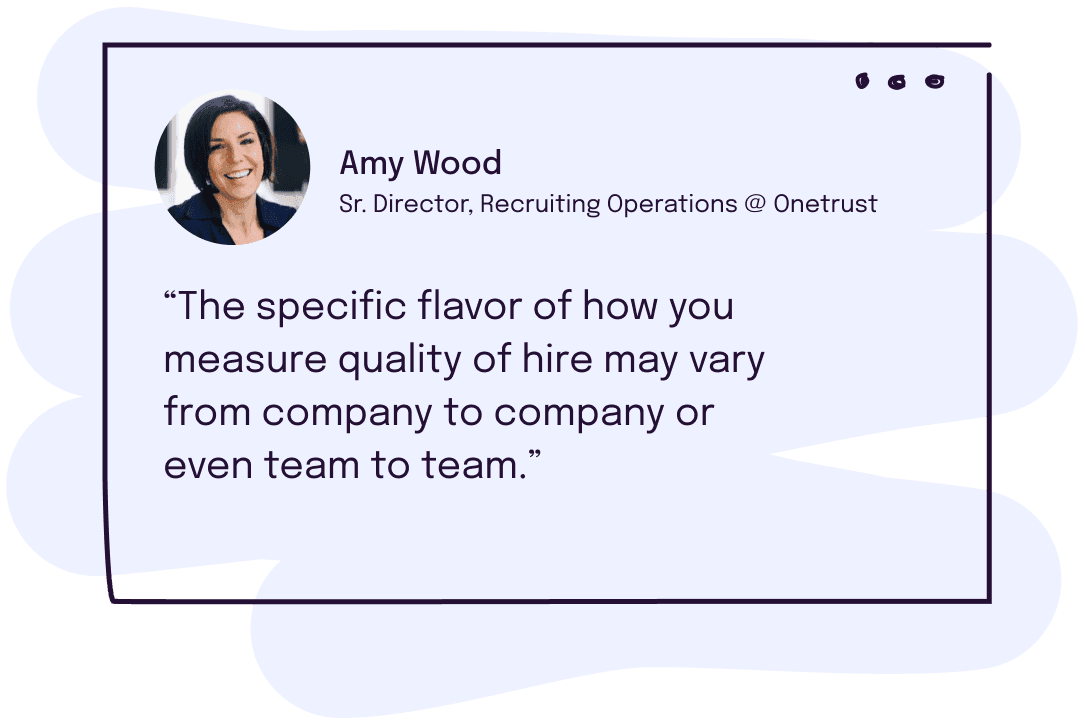Have you ever wondered how to go beyond the basics and truly evaluate the effectiveness of your hires?
You’re not alone. Quality of hire is the yardstick that separates good recruiting from excellent talent acquisition. Mastering it can transform your hiring process, impact your company culture, and boost your bottom line.
So, buckle up as we demystify how to measure quality of hire, delve into the key metrics you should be tracking, and serve up some actionable tips to help you start making progress today.
What is Quality of Hire?
Quality of hire is a holistic measure that captures the value new employees bring to your organization. This includes their performance, cultural contributions, and even their influence on team dynamics. It tells you how well your new hires help you achieve business objectives and fit into the larger organizational tapestry.
Why is Quality of Hire Important?
If you’re still on the fence about why quality of hire matters, consider this: a high-quality hire can lead to increased productivity, better work relationships, and a significant return on your investment.
On the flip side, a poor hire can set off a chain reaction of reduced morale, wasted resources, and increased turnover.
How to Measure Quality of Hire
Ah, the million-dollar question! Measuring quality of hire may seem daunting, but you’ve got this! There is no one-size-fits-all formula for quality of hire, but finding the right blend of metrics and measures for your organization is possible.
As Amy Wood, Senior Director, Recruiting Operations & Programs for Onetrust, puts it, “The specific flavor of how you measure quality of hire may vary from company to company or even team to team. Some roles naturally lend themselves to more quantifiable measurements, such as quota-carrying sales reps. So, it might be easiest to start there if you’re new to this measurement. Other roles may be more nebulous depending on your organization’s maturity.”

With that in mind, let’s look at some common categories you can consider when aligning on how to measure quality of hire at your organization.
Performance Metrics 📊
Performance metrics provide tangible data to evaluate the effectiveness of your recruitment process.
Time-to-Productivity: How quickly did your new hires reach what you would consider optimal productivity?
Performance Reviews: How do their review scores match up to team averages or predetermined goals?
Actionable Tip: Use performance review templates that capture quantitative scores along with qualitative feedback for a nuanced understanding of how your hires are performing.
Retention Rates 🗓️
Retention rates play a pivotal role in measuring quality of hire because they provide insights into how well a new employee is integrated into the company and whether they find long-term success within the organization.
Turnover Rate: Are your new hires sticking around, or do you find yourself back at square one far too often?
Actionable Tip: Conduct exit interviews to gather direct insights into what might be causing higher turnover rates among new hires.
Cultural Add 😎
Employees who complement and enhance your organization and team's values are more likely to stick around, fostering a positive work environment and contributing to a cohesive and harmonious team.
Employee Engagement Surveys: Are your hires engaged and satisfied in their roles? How is this trending over time?
Actionable Tip: Use engagement survey tools that allow for anonymous feedback, making it more likely for employees to share honest opinions.
Financial Metrics 💸
Some roles may have a direct correlation between their productivity and revenue generation.
Cost-to-Hire vs. ROI: Is the cost of acquiring a new hire justified by the value they bring?
Actionable Tip: Compare the cost-to-hire with the new hire’s revenue generation or cost-saving contributions for a quick ROI snapshot.
How to Improve Quality of Hire
So you’ve learned some of the metrics that can go into measuring quality of hire—now what? Let’s talk about tangible steps you can take to improve quality of hire.

Improve Your Recruitment Funnel 📈
An optimized recruitment funnel is your first line of defense in enhancing the quality of hire. Every step counts, from ensuring your job descriptions attract the right candidates to refining your interview techniques. Recruiting isn’t just about filling roles; it’s about building lasting relationships, improving the candidate experience, and ultimately boosting your ROI.
By optimizing your recruitment funnel, you can streamline your hiring process and reduce your time and cost per hire. You can also better ensure candidates are the proper fit, which can increase their retention and performance.
Finally, by creating a positive and memorable candidate experience from start to finish, you can enhance your employer brand and reputation, which can attract more talent and customers down the road for you.

Onboard Effectively 🙋🏽🙋🏻♀️
Successful onboarding can make or break a new hire’s experience and, by extension, their long-term success within the company. Implement a robust onboarding program that aids in quick acclimatization and productivity. Simple tactics like assigning a mentor or buddy for the initial weeks to help your new hires acclimate or mixing things up with e-learning modules and in-person sessions can make onboarding engaging, fun, and ultimately more successful.
By doing so, you can ensure that your new hires feel welcomed and supported, which can boost their confidence and motivation. You can also help them learn the ropes of their role and your organization’s culture and practices, which can accelerate their performance and contribution.
Additionally, by offering a variety of onboarding activities, you can cater to different learning styles and preferences, which can enhance the retention and comprehension of the information.

Create a Continuous Feedback Loop 🔁
Feedback shouldn’t be a one-off event but a continuous process. The more feedback you give and receive, the more opportunities you have to improve and adapt. Consider regularly soliciting feedback from new hires about the recruitment process and their onboarding. Put those learnings into action, and you’ll be well on your way toward making continuous improvement.
Creating a culture of feedback fosters learning and growth for both your organization and your new hires. It can also help quickly identify and address any issues or gaps that may arise during the hiring and onboarding stages. As an added bonus, by seeking feedback from new hires, you can demonstrate that you value their opinions and insights, which can increase their engagement and comfort levels.

Encourage Professional Development 🪴
Offering opportunities for career growth and skill development can significantly improve retention rates, positively impacting your quality of hire. Employees who feel valued and supported by their employers are likelier to stay loyal and engaged, reducing turnover costs and enhancing productivity.
Moreover, by providing training and development programs, employers can help their employees acquire new skills and competencies, which can increase their performance and overall job satisfaction while helping avoid burnout and feelings of stagnation.
In Closing
Understanding and optimizing your quality of hire isn’t just a ‘nice-to-have’—it’s a ‘must-have’ for any forward-thinking company. From identifying the right quality of hire metrics to implementing strategies for continuous improvement, it’s an approach that can fundamentally elevate your recruitment game.
Here’s to more thoughtful and more impactful hiring!
About Fetcher
Our mission is to help you engage talent that will transform your business aspirations into reality. Great talent is hard to find - that's why we offer a talent sourcing platform that not only gets your brand in front of the right candidates but also gives you a competitive edge in talent acquisition.
Begin building a relationship with your next great hire today and let Fetcher handle the rest. Learn more.




